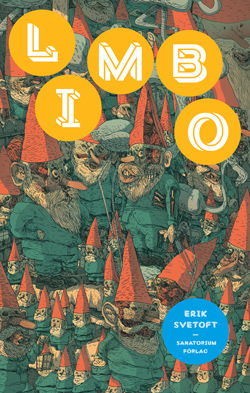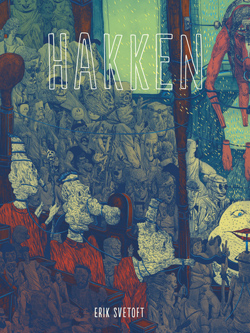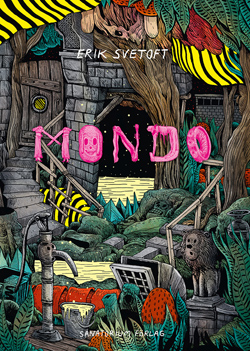< Back to posts
Erik Svetoft
Sweden

Erik Svetoft is an illustrator, animator and comic book artist living in Stockholm. He’s worked on a variety of commissions including comics for VICE and an animation with Jeff Östberg for the BBC. Erik’s latest book ‘Mondo’ was awarded a ‘Svensk Bokkonst Diploma’ for being one of the 25 best designed books in Sweden in 2017.
In this post, Erik talks about the creation of three of his books: ‘Limbo’, ‘Hakken’ and ‘Mondo’. These captivating comic books were designed by Jens Andersson and are published in Sweden by Jens’s publishing house, Sanatorium förlag.
Visit Erik Svetoft’s website
Visit Sanatorium förlag’s website
Erik: ‘Limbo’ is my first book that was published back in 2014. I was doing a Candidate Education in Design, and I had all these sketchbooks with material that I wanted to publish.
It all started with me getting in touch with Jens at Sanatorium about some ideas for the book…
Originally I was planning for it to be a collection of black and white sketchbook pages; I had about five hundred spreads done over a few years. Some of them ended up in the book along with colour illustrations on the theme of anatomy that I had been doing that year – exploring different bodies in varying states of decay and sort of falling apart, along with other illustrations and things.
I used to do a lot of comics growing up, but then illustration became the main focus for a while. ‘Limbo’ was all about illustrations and telling contained stories on each page – sort of sequential but not really – in the graphic novel way. With my next book, ‘Hakken’, I wanted to get back into doing more traditional sequential art and focus more on storytelling.
I don’t really have a plan when I start drawing. I like to have an element of surprise for myself to keep me interested and invested. The process is to have a very short synopsis or idea and then expand on it once I start sketching and drawing – trying to figure out what happens in the story while creating. Then I make small decisions constantly. That way it gets this spontaneous and unexpected quality that I can work with, creating new characters and plot lines along the way. Most of the time, I start somewhere in the middle of it and work my way forward and backwards. It’s not always a solid system and I make more traditional storyboards sometimes, but it makes for an interesting approach.
I also don’t really sketch things with pencil unless it is a bigger complex drawing or story; most of the time, I draw some guidelines and then ink right away. When I do comics with a lot of pages, I make quick storyboards though, just to see how the rhythm of the pages flow.
‘Hakken’ is almost entirely wordless and consists of a collection of short stories. There are some overarching themes, but mostly it’s experimentation with the graphic novel format and sequential art. I had this idea about trying to break up the narrative in my comics – not tell a story from point A to point B, but more like it’s a mood and atmosphere and things are happening in different time frames and places. Like a multi-plot.
It is both challenging and rewarding writing ideas down and translating them into visuals without using words. In some ways it adds another layer to the stories, opening them up for interpretation. I think most of my stories are pretty simple and straightforward though; there’s a level of dream logic, but mostly I like having a simple story frame.
The name of the book is taken from one of the short stories about a person having a nightmarish experience at a rave. Hakken is a dance associated with the Gabber music scene: very fast techno music. I used that music scene as a backdrop and then made a sort of a horror story out of it. I work around music a lot of the time, along with other references – like striving for the illustrations to have a ‘sound’ to them that you hear when you’re reading. I want to make pretty noisy drawings.
A lot of my inspiration is derived from other mediums than the ones I work with, like movies or music or video games. Sometimes ideas are mixed with things from real life, things that happen on the bus or other events. Sometimes it is a very vivid visual idea that I make a story out of. I like to just mix ideas and see what happens when they interact. I also like juxtaposing different moods and emotions in my work, funny and sad or terrifying all at once. If there is any kind of visceral response, I feel like I’m on to something.
My latest book, ‘Mondo’ is probably my most cohesive storytelling project so far in my career, again without using words or dialogue.
I started working on ‘Mondo’ right after ‘Hakken’ had been released, so it’s sort of a continuation of my storytelling experiments from before. The goal was to make a cohesive story, working on a larger scale with storytelling. I felt much more confident this time around with what I wanted to do and with my process.
The book is a mix of full page illustrations and comics and sequential art. Some locations and backgrounds are based on real places around Sweden that I have either lived in or that I have some relation to, mixed with imaginary places and settings.
The focus is on short stories leading into each other with a main storyline and theme running through them all with a small segue in-between. I was trying to think of a very simple character to follow, and it turned into a dog-like thing with a blank happy expression traversing a strange world and getting mixed up with different characters’ lives.
Thematically, all the stories blend together; they all go in different directions though.
I think of my writing process as a sort of collage. Puzzles to figure out where things fit in.
The name of the book is partly taken from ‘Il Mondo’, which is Italian for ‘The World’ and also from an Italian documentary from the 60s called ‘Mondo Cane’ (A Dog’s Life). The musician Mike Patton also has a project where he sings in Italian under that name. It kind of made sense with the main character being a dog-thing and the theme of exploring an imaginary world. It is also a very monumental word; it looks good even without any meaning. A good name is always important.
Illustrations © Erik Svetoft. Post edited by dPICTUS.
Limbo
Erik Svetoft
Sanatorium, Sweden, 2014
Erik Svetoft’s debut book is unlike anything else… It’s a collection of pictures and an art book which introduces us to Erik’s captivating and distorted worlds.
Every book is unique, as the title is stuck on manually to each cover.
Hakken
Erik Svetoft
Sanatorium, Sweden, 2016
Through five wordless stories, Erik Svetoft brings us many more characters and scenes which are distinctive, dynamic, distorted, and fascinating.
Although there are some overarching themes in ‘Hakken’, Erik’s approach to this book was an experiment with the graphic novel format and with sequential art.
Mondo
Erik Svetoft
Sanatorium, Sweden, 2017
Mondo is a collection of short stories with a main storyline and theme running through them. Mondo creeps under the skin of its reader and stays there…
Awarded a ‘Svensk Bokkonst Diploma’ for being one of the 25 best designed books in Sweden in 2017.
‘Mondo is an incredibly rich piece of work. Comic book absurdity at its finest.’
—Swedish Arts Council: New Swedish Books 2017




























